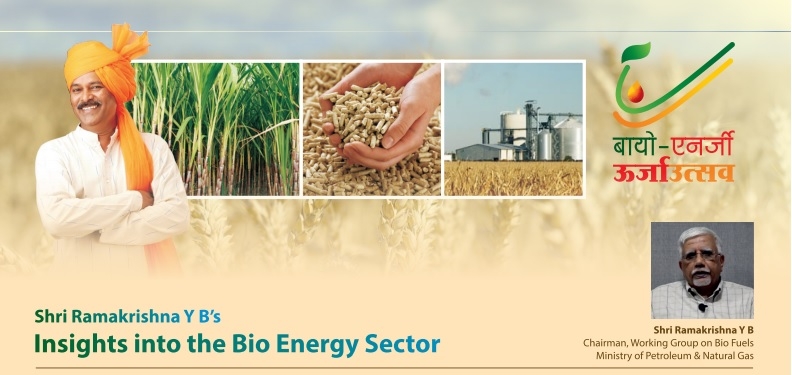Insights into the Bioenergy Sector - Shri Ramkrishna YB

What is this Bio Energy Urja Utsav All about and what is it for a common man in there?
Bio energy is renewable energy produced out of organic matter. 60% population in our agrarian economy depends on agriculture and it’s just the remaining 40% that looks for other sources of livelihood. While we as a society have been already been using this energy for years, many are still unaware of the very fact that they are already part of this eco-bio energy cycle. The two day Bio Energy Utsav aims at creating awareness for common people like farmers and students and also will provide a platform to the researches and entrepreneurs to showcase their findings, papers and products. It will be a great platform for like minded people to connect and together contribute to the growing sector of bio energy.
The Bio Energy Urja Utsav is just a curtain raiser for the Bio Energy Programme by the Bio Fuel Group. What does this programme aim?
Bio mass - the largest source for bio energy is produced out of trees and plants, residues from agriculture or forestry, and the organic component of municipal and industrial wastes. Currently 1 billion ton bio mass is being generated out of available bio mass and most of it is used as manure or fodder or fuel in villages. But around 1/3rd of the available bio mass is burnt out as farmers do not know what is to be done with it and they need the fields cleared for the next crop. India has the largest arable land available and much of its land is barren or what we call as wasteland (Approx 100 million hectares). I call it wasted land. So land as a resource is underutilised, residue as a resource is underutilised; the municipal solid waste in urban areas is dumped in landfills.
We are looking at the various types wasted resources that we have in the country and see whether it is possible for us to recover energy out of it or to convert it into useful products. Technologies to ensure efficient and full burning of bio Mass and cooking and heating energy and electricity, efficient bio manure instead of chemical fertilizers, more efficient fuel generation for better energy is what the programme will aim for. We know that bacteria that eat the waste food release methane into the atmosphere contributing to GHG emissions. But if we capture methane and convert it to fuel it is the cleanest fuel because of its lesser carbon content. Pure methane at 97% is nothing but CNG which can be used for transport. Our bio energy programme encapsulates this and more. We are talking about a new Bio Economy in making here.
What are the biggest challenges that you feel in this developing sector of Bio Energy?
In the bio-fuel production from ethanol, India largely depends on the sugarcane molasses. As per a survey, availability of molasses has come down; availability of ethanol has come down. So we have been able to achieve only 4-5% ethanol blending in petroleum. So even bio mass while being burnt can give cellulose to produce ethanol. Unfortunately we do not have a system of collecting the biomass and we have challenges in the supply chain part of it. Farmers can give the bio mass as agricultural residue only in those two three weeks between harvesting a crop and sowing the next one. So our challenges include bio mass storage for the rest of the year, making the programme commercially viable through new emerging technology and supply it to the world instead of being borrowers, putting the wastelands to use to grow trees bearing non edible oil seeds for producing bio diesel. Without going in technical details these are a few challenges that I can enumerate.
How do you think an enhanced Bio Energy sector can contribute directly into the national economy?
When we talk about other programs like Swacch Bharat, doubling farmer’s income, Skill Development, Make In India, all these can be aided by our bio energy programme. As here we are talking about our own resources, our own technologies, meeting our local energy needs and for the whole country and the world. Rural entrepreneurship, women empowerment, skilling India all components can be contained in this programme.
What role do you see NYCSIndia playing in the Bio Energy Urja Utsav ? How has its contribution benefitted the programme ?
As I said, though this Utsav is a two day event, we see this as a mission – an Abhiyaan to reach people. Government is doing its bit to extend the outreach but if it has to be a “Abhiyan”, it needs participation from all stakeholders of the society. With due support from government, we also needed a committed set of people who are very well networked throughout the country who will be able to take this programme to the people and build this into an “Abhiyan”. This is where NYCS Plays an important role. The way NYCS has its presence in almost every district of this country and with the kind of committed leadership and committed members it can take this programme to the masses. NYCS can become a very important and crucial vehicle to drive any kind of People’s Movement and that is why it has been recognized by the ministry to associate in conducting this kind of endeavour. We are looking forward for the association beyond this two day programme and into a long run in the future.
- Shri. Ramkrishna YB

